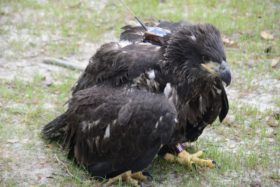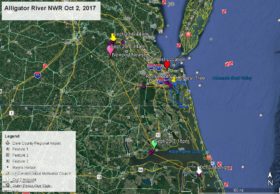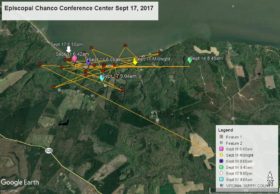Self Feeding
Azalea Still Feasting on Catfish
April 19, 2010Catfish, Catfish and More Catfish
April 21, 2010
Categories


April 19 marks a major milestone for two of the three eaglets. For the first time NC and #2 fed themselves. Between 7:05 and 7:24 this evening NC first stood on the fish and pulled pieces off (photo #1), and then chick #2 did the same (photo #2). It takes muscle, coordination, balance and the ability to stand up before eagles can feed for themselves. For the past few days all three eaglets have been observed pecking at a fish while one of the adults stood on the fish. For the next few days the adults will still feed the chicks, but by next week the chicks will be on their own to feed on food brought to the nest and left for them.




6 Comments
Reese…it was so exciting today to watch the the adults eating in front of the chicks and not feed…”this is how it’s done”.
And tonight…they did it! 🙂
Ann – The chicks learn quickly. Sunday evening, dad stood on a fish as all three pulled at the fish. 24 hours later they are doing it for themselves, We can’t see all that is going on at the feeding this morning, but it appears that dad is breaking off pieces of fish and the chicks are picking it up.
that was fun to watch– thanks for being on cam
And we thought our “children” grew up fast. My oh my, what a wonderful thing. It never fails to amaze me how good these parents are. We must have a really smart batch this time, and so young! Good for them. Thanks for the tid bit of news Reese.
They are growing up too quickly! Doesn’t seem possible that they are already starting to feed themselves. Before long they will be flying. This season is going by too quickly! Thanks for the update.
What a great website. It’s amazing to watch these little guys grow and develop. I am new to your blog so I am going back and catching up. But I had to leave a comment and commend your efforts! Thanks!